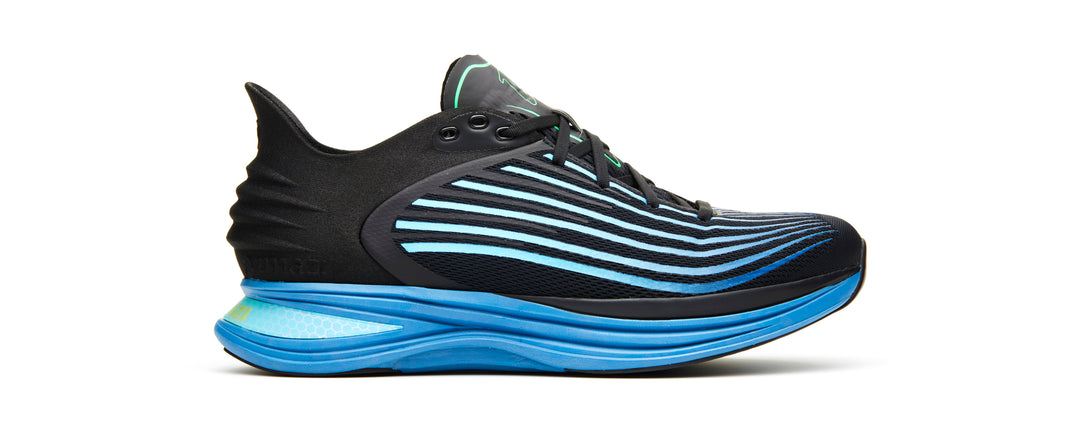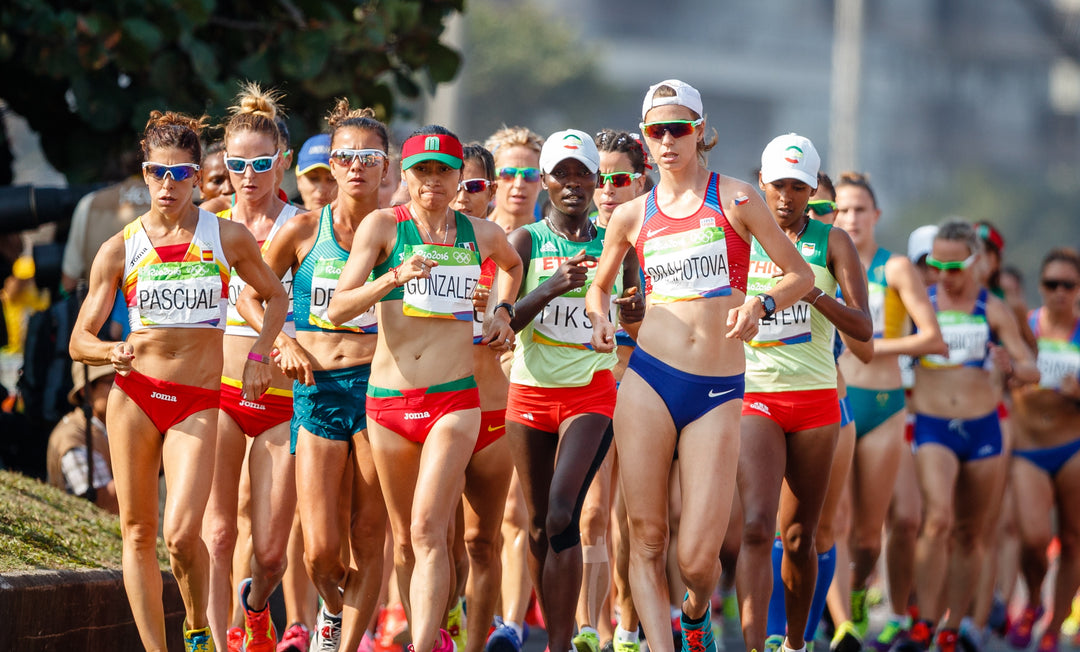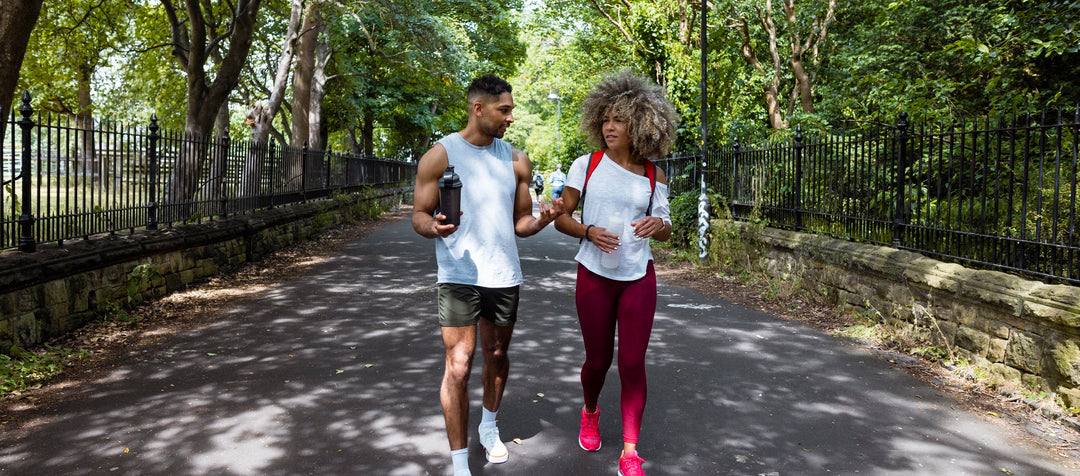Breaking the 3:30 marathon barrier is a huge milestone for most runners, and you should approach the project with a combination of excitement and dread. To cross the finish line under your goal, you’ll need to run just about exactly 8:00 per mile for the entire 26.2 miles. You’re not going to do that off the couch. I can attest from painful experience.
But with a strong base, a smart plan, and consistent follow-through, a 3:30 marathon is possible for a lot of runners. You just need to string together a whole bunch of those 8 minute miles. To accomplish that, running in the pace-tuned Vimazi Z50 would be ideal, since it’s engineered to perform best between 7:15-8:45 min/mi.
I’ve been running marathons for more than 25 years, studied lots of training strategies and plans, and even, along with Scott Tucker, written an interval training book for distance runners (Running in Circles). From my experience, these are best ways to think about and prepare for breaking 3 hours 30 minutes in a marathon.
1. Start with a Proper Base: As I said, there’s no off the couch magic happening in a marathon. Before you start your official training plan, you should build a proper base of aerobic fitness. This can include running a mix of easy and long runs, as well as some cross-training like cycling, swimming, or hiking. The key is to build a solid foundation. Your marathon training goes on top of that.
You have to have a good base, but if you’ve never run a marathon before and don’t have a good idea about your ability, a 3:30 marathon is likely too much of a reach. I recommend racing some 10Ks and half marathons first.
The rule of thumb is that you should be able to run a 1:37 half marathon or sub 43 minute 10K before you have a chance at running a 3:30 marathon. There are lots of 12-week training plans out there, but you can only rely on those if you’ve built a solid base of consistent running and broken 1:37 for a half.
2. Build your training plan: Your goal is a 3:30 marathon. Training plans can be as short as 12 weeks or as long as 6 months. Longer is better. A longer plan gives you more time to build up slowly, which can reduce your chance of injury. A longer build up also allows for the unplanned, like a cold or business trip or adverse weather or you’re just too dang tired to run today.
Ideally, you create a 20-week plan that’s surrounded on either side by many months or years of running and general fitness. The 20-week block is more intensive and focused. Your plan should be written out in advance. Making it up along the way is no good, especially if your marathon goal is 3:30 (or 3:29:59, to be more precise).
The plan should include a mix of running, with some strength and core training, plus some active stretching. Plan to run 5-6 days per week. I’ve found 5 works best for me as my body needs extra recovery time, but you’ll find a lot of runners out there on epic run streaks who never take a day off. The plan should include a two to three week taper at the end when you reduce your mileage by 15-20% each of the last few weeks. Here’s the basic plan I’ve used to good success.
Sunday - easy and short
Monday -rest
Tuesday - intervals
Wednesday - medium length run
Thursday - tempo or fartlek run
Friday - rest or very short and easy
Saturday - long run
3. Track your progress: As you train, make sure to track your progress, either in a digital spreadsheet or in a notebook. This has the dual benefit of both keeping your consistency honest and monitoring your fitness. Tracking your efforts can give you an early alert that your 3:30 goal is too much of a reach or, alternatively, too conservative.
4. Stay Consistent: Consistency is key when training for a marathon. It’s critical before your training block begins, but even more important during the block. Just make sure you give your body enough time to recover between sessions. Another aspect of consistency is preparing for race day. On every long run I try to hydrate and fuel as if I was in the race. That way I know how my body will respond, for instance, to that fourth gel. This is not an experiment you want to run at mile 19 during your race.
5. Increase Your Mileage: The basic tenet of running any marathon, but especially when the goal is under 3:30, is increasing your mileage. Your plan should clearly state how many miles each week and each day. The rule of thumb is that you shouldn’t increase your weekly mileage more than 10% from one week to the next. Some coaches quibble with this number, but it’s pretty solid. When you’re running fewer than 12 miles a week or more than 65 miles a week, the 10% rule may not apply. The rule gets considerably more critical when you’re older than 35! This is, unfortunately, something I know about.
One of the things we know a lot about at Vimazi is the force you generate at a given pace. Force, even more than miles, is the thing you really need to watch as you increase your mileage. 30 miles at 6 minutes per mile is much harder on your body than 40 miles at 10 minutes per mile. So definitely factor in your pace when increasing mileage while using the 10% rule.
You should be running 15-20 miles a week when you start out, and build to a max of at least 35-55 miles a week two weeks prior to the race. Build gradually!
6. Increase Your Long Runs: Long runs are the one necessary feature of any successful marathon training block. Most coaches say you should get in at least a couple 20 milers near the end of your plan. If you haven’t run a strong 18 mile run before the race, hitting your goal will be tough. Staring into the annihilated-legs abyss at 22 miles is not something I’d wish on anybody.
Keep the pace on these long runs relatively easy. As long as you’re doing a little speed work, the long runs can be 30-90 seconds slower than goal race pace. That would be 8:30 to 9:30 minutes per mile if you plan to hit 3:30 on the head. We’ve engineered the Vimazi Z60 to perform best in that pace range. That said, throwing down 3-6 miles at 8 min/mile during your long run will help explain to your legs what race pace feels like. So make that happen.
7. Incorporate Tempo Runs: Tempo runs or “threshold runs” are important for marathon training. Aim for one tempo run per week and focus on running at a slightly challenging pace for the duration of the run. With a 3:30 marathon goal, you can’t do better than the Vimazi Z50 (7:15-8:45 min/mi, 4:30-5:25 min/km) on tempo runs. In addition to tempo runs, some of your long runs should be in the Z50. It’s your race shoe after all.
8. Do Speed Workouts: Speed workouts are an essential part of any marathon training plan, but even more so if you’re trying to break 3:30. Speed workouts help to increase your endurance and pace, both of which are essential for stringing together 8 minute miles. I enjoy going to the track because you can be precise about your intervals, but 2-5 minutes hard followed by a couple minutes of easy jogging out on the road or trail gets the job done. For a fresh take on interval training, check out my book Running in Circles: Sciencey, Gamey, Head-Scratchy Track Workouts for Faster Running.
9. Take Rest Days: At some point along the way, you’re going to feel amazing. Resist the urge to ignore your plan and hammer your rest days. Rest days are just as important as any other day in your training plan. You need to give your body time to recover in order to ensure that you’re not overtraining or risking injury. It’s much better to take more rest days and finish the race than to burn out or blow up. It’s cliche, but listen to your body.
10. Stay Motivated: Breaking 3:30 in a marathon is no easy feat, and it’s going to require hard work and dedication. So staying motivated is easier said than done, especially over 20 weeks. Mixing up your running routes, changing the intervals and tempo runs, scheduling runs with partners, reading Runner’s World, picking up some new shorts, and buying a new pair of shoes can all help with sustaining motivation. You can also take a day or two off. Remember why you’re doing this in the first place. It was your choice! So don’t let yourself down. Visualizing yourself crossing the finish line in under 3:30 can be another great way to keep the motivation turned up to high.
11. Race: Participate in a few shorter races leading up to your marathon. This will give you a chance to practice race day strategy and get comfortable with a faster sustained pace. For a 10K, you may want to lace up the Vimazi Z40, which is tuned for 6:15-7:45 min/mi (3:55-4:45 min/km). Don’t race too much. I’d recommend running a half marathon eight or ten weeks out and a 5K or 10K four to six weeks prior.
12. Focus on Your Nutrition: Nutrition is an important component of any training plan, but even more so when you’re trying to break 3:30. Eating the right foods before, during, and after your runs will help to fuel your body and ensure that you have the energy to sustain your pace for the entire race.
13. Enjoy the experience: Remember to have fun and enjoy the journey. Grinding through 20 weeks of intensive training without any joy is not the point. Keep it fun.
14. Practice and Visualize: If you can do some of your long runs on the marathon course, that will help the cause on race day. Practice on terrain similar to the race you’re planning, and visualize yourself at different stages of the race. Be sure to make a race-day plan, including what you plan to wear, eat, drink, and your pacing strategy.
It’s a huge milestone to break 3:30 in a marathon, and congrats to you if you get it done. Best of luck next time if you miss your goal. By training properly and following these tips, you’ll put yourself in the best position for crossing the line before the clock clicks past the 3:30 mark. Let’s Go!
More About Vimazi
Here’s what Vimazi does
We make pace-tuned running shoes that provide better cushioning and more efficiency than previous generations of running shoes.
The physics of pace-tuned shoes
Back in 2017, while Vimazi CEO Scott Tucker was running to his 6am interval workout, he had an idea. A shoe made for a specific pace, he thought, might offer better cushioning and more propulsive efficiency than a generic shoe that wasn’t “tuned” for a particular pace.
It took three years to fully understand the physics of human running, and the forces that are generated. When we finally understood the physics, we built an equation that defines running forces. We’re now able to calculate the exact impact force and propulsion force, in Newtons, for any pace, including variations for height, weight, and cadence. (A Newton is a metric unit of force.) Data from the Forces in Running study we conducted aligned with the force calculations we got from the physics. In other words, we know it works.
Knowing the precise impact and propulsion forces at each pace, allowed us to create shoe models for different pace zones. So our pace-tuned technology is based on pure physics. No hand waving, no conjecture, no correlative studies, no self-reported data sets, no marketing fluff. We started with the physics of human running, and it led us to pace-tuned shoes.
The problem with previous gen running shoes
Most running shoes have the same foam density from heel to toe, and they’re sold to runners of every pace. The trouble is that midsole foam can’t respond correctly to the forces at all paces, and it can’t even respond appropriately to the differences between impact and propulsion forces. To make sure you get all the cushioning you want as well as all the efficiency you deserve, you need a shoe that’s made for a specific pace zone and tuned differently in the heel than the forefoot.
The Vimazi solution
Our solution to this running shoe problem was to create something that's never been done before—pace-tuned running shoes. In 2023, after years of testing, we launched seven road shoe models that span paces from 4:30 minutes per mile to 15 minutes per mile (2:50-9:30 minutes per kilometer). By making a shoe for a specific pace zone, we’ve been able to deliver better impact cushioning and propulsion efficiency for every runner.
25 years experience
We’ve taken everything we learned making running shoes for 25 years—and running marathons for even longer—and elevated it to a whole new level with pace tuning. It offers a better and more personal running experience. We were instrumental in creating shoes for Montrail, Scott Sports, and Pearl Izumi. We learned even more while owning a specialty running store and organizing running events.
A marathoner’s fit
Running shoes can have the best tech, but if they don’t fit well, nobody will wear them. We wouldn’t either! Not only have we spent our careers perfecting innovative fit technologies at other companies, notably at Montrail, we’re also life-long marathon runners ourselves. So we understand fit and know how critical it is, from heel to toe. Each of our models has been painstakingly designed and built with the perfect fit in mind. They’ve also been extensively road tested since 2019, including at the Boston, London, Portland, Missoula, San Antonio, and Two Oceans Marathons. We think you’ll love them.









Leave a comment